FeinPhone: Low-cost Smartphone Camera-based 2D Particulate Matter Sensor
Abstract
1. Introduction
2. Related Work
3. Measurement Principle
3.1. Light-Scatter Trace Counting
3.2. Optical Parameters
4. The FeinPhone System
4.1. Hardware Design
4.2. Algorithm Design
4.2.1. Contour Detection Particle Counting (CDPC)

4.2.2. Poisson Particle Detection (PPD)

5. Evaluation
- MOG2 learning rates of , , and
- number of standard deviations for Gaussian blur of 5 and 9
- threshold for binarization of 10, 50 and 100
- threshold for contour detection of 10, 50, 100, and 500
- shifting
- smoothing
- interpolating
6. Discussion
6.1. Ventilated vs. Unventilated
6.2. Detection Size Limit
6.3. Computational Requirements
7. Conclusions
Author Contributions
Funding
Acknowledgments
Conflicts of Interest
Abbreviations
| ABS | Acrylonitrile Butadiene Styrene |
| AD | Aerodynamic Diameter |
| APS | Aerodynamic Particle Sizer |
| BC | Black Carbon |
| CCD | Charge-Coupled Device |
| CDPC | Comtour Detection Particle Counting |
| CMOS | Complementary Metal–Oxide–Semiconductor |
| ISO | Camera exposure index rating |
| LED | Light Emitting Diode |
| MEMS | Microelectromechanical systems |
| PLA | Polylactic Acid |
| PM | Particulate Matter |
| PPD | Poisson Particle Detection |
| RGB | Red, Green, Blue (color model) |
| SMPS | Scanning Mobility Particle Sizer |
| SPEX | Spectropolarimeter for Planetary Exploration |
| SPP | Spatial Poisson Process |
| WCCAP | World Calibration Center for Aerosol Physics |
| WMO | World Meteorological Organization |
References
- World Health Organization (WHO). Health Aspects of Air Pollution With Particulate Matter, Ozone And Nitrogen Dioxide; Report on a Who Working Group; World Health Organization (WHO): Geneva, Switzerland, 2003. [Google Scholar]
- Chen, Y.; Ebenstein, A.; Greenstone, M.; Li, H. Evidence on the impact of sustained exposure to air pollution on life expectancy from China’s Huai River policy. Proc. Natl. Acad. Sci. USA 2013, 110, 12936–12941. [Google Scholar] [CrossRef] [PubMed]
- Rückerl, R.; Schneider, A.; Hampel, R.; Breitner, S.; Cyrys, J.; Kraus, U.; Gu, J.; Soentgen, J.; Koenig, W.; Peters, A. Association of novel metrics of particulate matter with vascular markers of inflammation and coagulation in susceptible populations–results from a panel study. Environ. Res. 2016, 150, 337–347. [Google Scholar] [CrossRef] [PubMed]
- Snyder, E.G.; Watkins, T.H.; Solomon, P.A.; Thoma, E.D.; Williams, R.W.; Hagler, G.S.W.; Shelow, D.; Hindin, D.A.; Kilaru, V.J.; Preuss, P.W. The Changing Paradigm of Air Pollution Monitoring. Environ. Sci. Technol. 2013, 47, 11369–11377. [Google Scholar] [CrossRef] [PubMed]
- Mukherjee, A.; Stanton, L.G.; Graham, A.R.; Roberts, P.T. Assessing the utility of low-cost particulate matter sensors over a 12-week period in the Cuyama Valley of California. Sensors 2017, 17, 1805. [Google Scholar] [CrossRef] [PubMed]
- Broday, D.M. Citi-Sense Project Collaborators. Wireless Distributed Environmental Sensor Networks for Air Pollution Measurement—The Promise and the Current Reality. Sensors 2017, 17, 2263. [Google Scholar] [CrossRef] [PubMed]
- Nova Fitness Co. Ltd. SDS011 sensor. 2015. Available online: https://nettigo.pl/attachments/398 (accessed on 15 November 2017).
- LUBW. Messungen mit dem Feinstaubsensor SDS011 - Ein Vergleich mit einem eignungsgeprüften Feinstaubanalysator. 2017. Available online: http://www4.lubw.baden-wuerttemberg.de/servlet/is/268831/ (accessed on 24 January 2018).
- Budde, M.; Schwarz, A.D.; Müller, T.; Laquai, B.; Streibl, N.; Schindler, G.; Köpke, M.; Riedel, T.; Dittler, A.; Beigl, M. Potential and Limitations of the Low-Cost SDS011 Particle Sensor for Monitoring Urban Air Quality. ProScience 2018, 5. [Google Scholar] [CrossRef]
- Budde, M.; El Masri, R.; Riedel, T.; Beigl, M. Enabling Low-Cost Particulate Matter Measurement for Participatory Sensing Scenarios. In Proceedings of the 12th International Conference on Mobile and Ubiquitous Multimedia (MUM 2013), Luleå, Sweden, 2–5 December 2013. [Google Scholar] [CrossRef]
- Holstius, D.M.; Pillarisetti, A.; Smith, K.; Seto, E. Field calibrations of a low-cost aerosol sensor at a regulatory monitoring site in California. Atmos. Meas. Tech. 2014, 7, 1121–1131. [Google Scholar] [CrossRef]
- Retsch Technology. CAMSIZER X2 Product Information. 2017. Available online: https://www.retsch-technology.de/de/api/?action=product_pdf&productId=399&id=2296509&L=6&print_info=1&print_image=1&print_examples=1&print_advantages=1&print_features=1&print_principle=1 (accessed on 18 November 2017).
- Proietti, A.; Leccese, F.; Caciotta, M.; Morresi, F.; Santamaria, U.; Malomo, C. A new dusts sensor for cultural heritage applications based on image processing. Sensors 2014, 14, 9813–9832. [Google Scholar] [CrossRef] [PubMed]
- Proietti, A.; Panella, M.; Leccese, F.; Svezia, E. Dust detection and analysis in museum environment based on pattern recognition. Measurement 2015, 66, 62–72. [Google Scholar] [CrossRef]
- Ramanathan, N.; Lukac, M.; Ahmed, T.; Kar, A.; Praveen, P.; Honles, T.; Leong, I.; Rehman, I.; Schauer, J.; Ramanathan, V. A cellphone based system for large-scale monitoring of black carbon. Atmos. Environ. 2011, 45, 4481–4487. [Google Scholar] [CrossRef]
- Poduri, S.; Nimkar, A.; Sukhatme, G.S. Visibility Monitoring using Mobile Phones. Technical Report, Department of Computer Science, USC. 2010. Available online: http://citeseerx.ist.psu.edu/viewdoc/summary?doi=10.1.1.173.4647 (accessed on 24 January 2018).
- Snik, F.; Rietjens, J.H.; Apituley, A.; Volten, H.; Mijling, B.; Di Noia, A.; Heikamp, S.; Heinsbroek, R.C.; Hasekamp, O.P.; Smit, J.M.; et al. Mapping atmospheric aerosols with a citizen science network of smartphone spectropolarimeters. Geophys. Res. Lett. 2014, 41, 7351–7358. [Google Scholar] [CrossRef]
- Carminati, M.; Pedalà, L.; Bianchi, E.; Nason, F.; Dubini, G.; Cortelezzi, L.; Ferrari, G.; Sampietro, M. Capacitive detection of micrometric airborne particulate matter for solid-state personal air quality monitors. Sens. Actuators A 2014, 219, 80–87. [Google Scholar] [CrossRef]
- Doering, F.L.; Paprotny, I.; White, R.M. MEMS air-microfluidic sensor for portable monitoring of airborne particulates. In Proceedings of the 2012 Solid-State Sensors, Actuators and Microsystems Workshop, San Diego, CA, USA, 3–7 June 2012. [Google Scholar]
- Budde, M.; Barbera, P.; El Masri, R.; Riedel, T.; Beigl, M. Retrofitting Smartphones to be Used as Particulate Matter Dosimeters. In Proceedings of the 17th International Symposium on Wearable Computers (ISWC’13), Zurich, Switzerland, 8–12 September 2013; pp. 139–140. [Google Scholar] [CrossRef]
- Budde, M.; Köpke, M.; Beigl, M. Design of a Light-scattering Particle Sensor for Citizen Science Air Quality Monitoring with Smartphones: Tradeoffs and Experiences. ProScience 2016, 3, 13–20. [Google Scholar] [CrossRef]
- Scully, C.G.; Lee, J.; Meyer, J.; Gorbach, A.M.; Granquist-Fraser, D.; Mendelson, Y.; Chon, K.H. Physiological Parameter Monitoring from Optical Recordings With a Mobile Phone. IEEE Trans. Biomed. Eng. 2012, 59, 303–306. [Google Scholar] [CrossRef] [PubMed]
- Pelegris, P.; Banitsas, K.; Orbach, T.; Marias, K. A Novel Method to Detect Heart Beat Rate Using a Mobile Phone. In Proceedings of the 2010 Annual International Conference of the IEEE Engineering in Medicine and Biology, Buenos Aires, Argentina, 31 August–4 September 2010. [Google Scholar]
- Lamonaca, F.; Carní, D.L.; Grimaldi, D.; Nastro, A.; Riccio, M.; Spagnolo, V. Blood oxygen saturation measurement by smartphone camera. In Proceedings of the 2015 IEEE International Symposium on Medical Measurements and Applications (MeMeA), Turin, Italy, 7–9 May 2015. [Google Scholar]
- Bui, N.; Nguyen, A.; Nguyen, P.; Truong, H.; Ashok, A.; Dinh, T.; Deterding, R.; Vu, T. PhO2: Smartphone Based Blood Oxygen Level Measurement Systems Using Near-IR and RED Wave-guided Light. In Proceedings of the 15th ACM Conference on Embedded Network Sensor Systems, New York, NY, USA, 6–8 November 2017; ACM: New York, NY, USA, 2017; pp. 26:1–26:14. [Google Scholar] [CrossRef]
- O’Driscoll, S.; MacCraith, B.D.; Burke, C.S. A novel camera phone-based platform for quantitative fluorescence sensing. Anal. Methods 2013, 5, 1904–1908. [Google Scholar] [CrossRef]
- Klein, R.D. RadioAcivity—RadioactivityCounter for Mobile Phones. Available online: http://www.hotray-info.de/html/radioactivity.html (accessed on 21 November 2017).
- Lane, N.; Miluzzo, E.; Lu, H.; Peebles, D.; Choudhury, T.; Campbell, A. A survey of mobile phone sensing. IEEE Commun. Mag. 2010, 48, 9. [Google Scholar] [CrossRef]
- Budde, M.; Köpke, M.; Beigl, M. Robust In-situ Data Reconstruction from Poisson Noise for Low-cost, Mobile, Non-expert Environmental Sensing. In Proceedings of the 19th International Symposium on Wearable Computers (ISWC’15), Osaka, Japan, 7–11 September 2015. [Google Scholar] [CrossRef]
- Bradski, G. The OpenCV Library. Available online: http://www.drdobbs.com/open-source/the-opencv-library/184404319 (accessed on 7 January 2019).
- Zivkovic, Z. Improved adaptive Gaussian mixture model for background subtraction. In Proceedings of the 17th International Conference on Pattern Recognition (ICPR 2004), Cambridge, UK, 26 August 2004; Volume 2, pp. 28–31. [Google Scholar]
- Zivkovic, Z.; Van Der Heijden, F. Efficient adaptive density estimation per image pixel for the task of background subtraction. Pattern Recognit. Lett. 2006, 27, 773–780. [Google Scholar] [CrossRef]
- TSI. Aerodynamic Particle Sizer Model 3321. 2017. Available online: http://www.tsi.com/uploadedFiles/_Site_Root/Products/Literature/Spec_Sheets/3321.pdf (accessed on 13 November 2017).
- Wiedensohler, A.; Birmili, W.; Nowak, A.; Sonntag, A.; Weinhold, K.; Merkel, M.; Wehner, B.; Tuch, T.; Pfeifer, S.; Fiebig, M.; et al. Mobility particle size spectrometers: Harmonization of technical standards and data structure to facilitate high quality long-term observations of atmospheric particle number size distributions. Atmos. Meas. Tech. 2012, 5, 657–685. [Google Scholar] [CrossRef]
- Budde, M. Distributed, Low-Cost, Non-Expert Fine Dust Sensing with Smartphones. Ph.D. Thesis, Karlsruhe Institute of Technology (KIT), Karlsruhe, Germany, 2018. [Google Scholar]
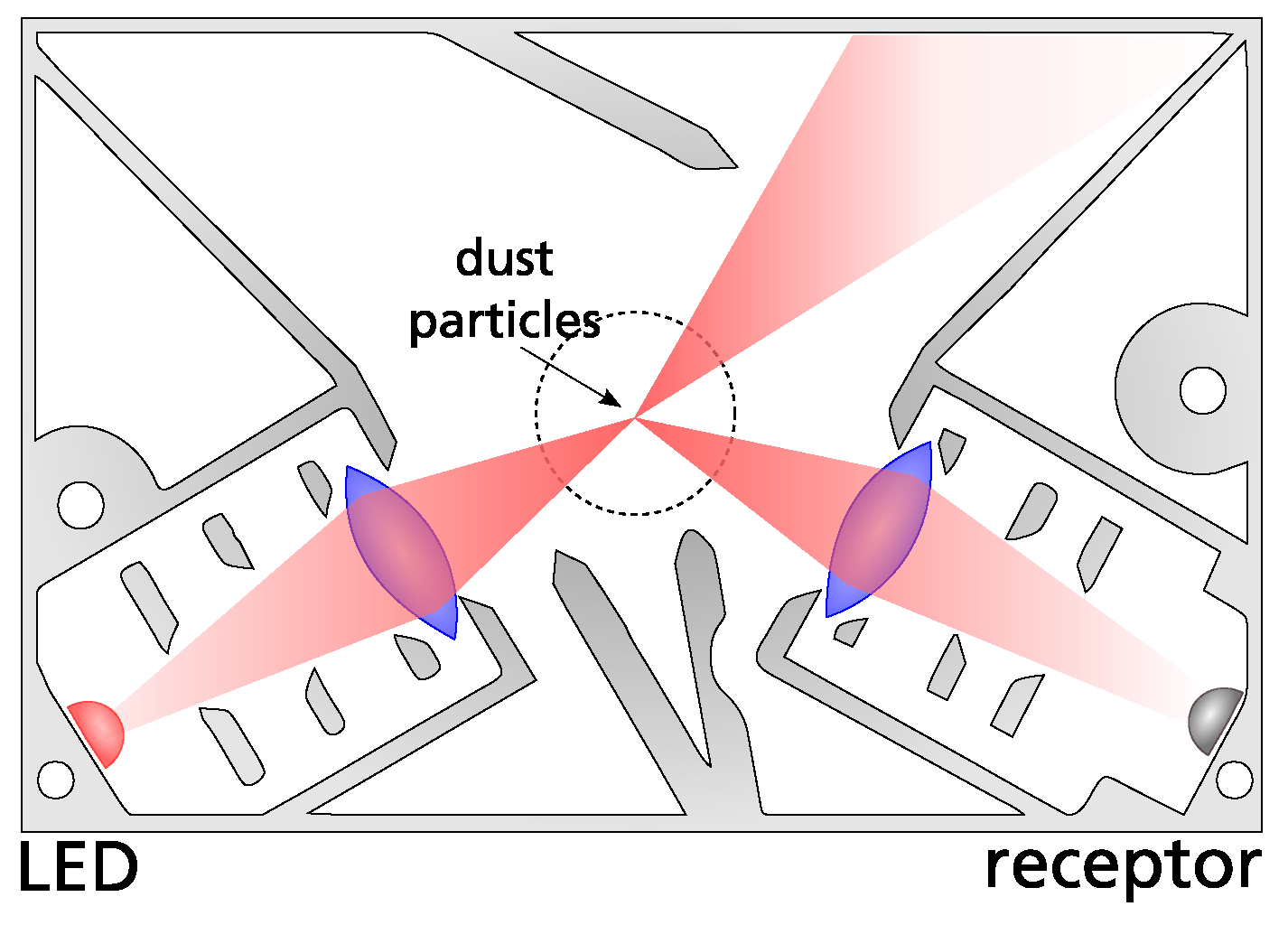

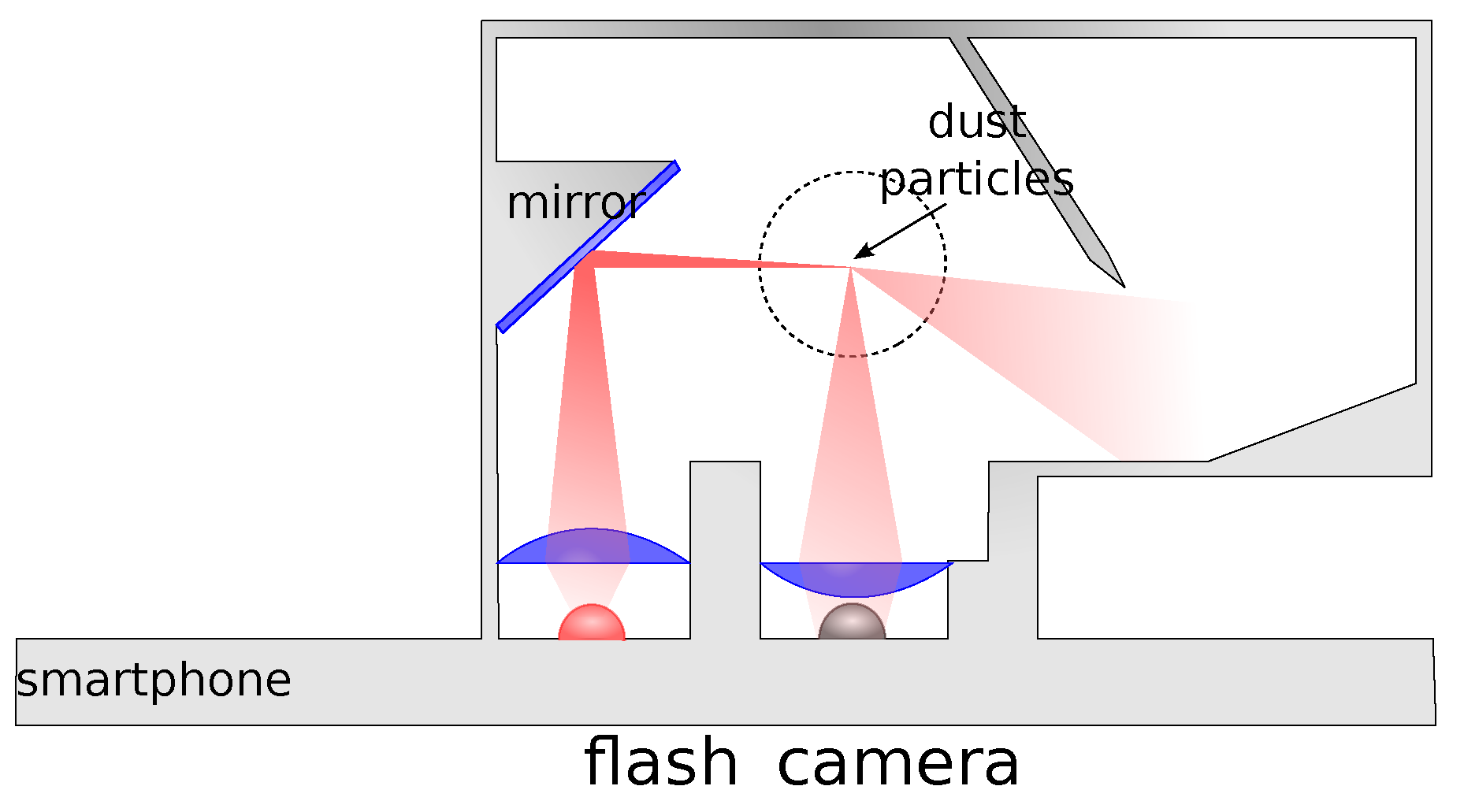
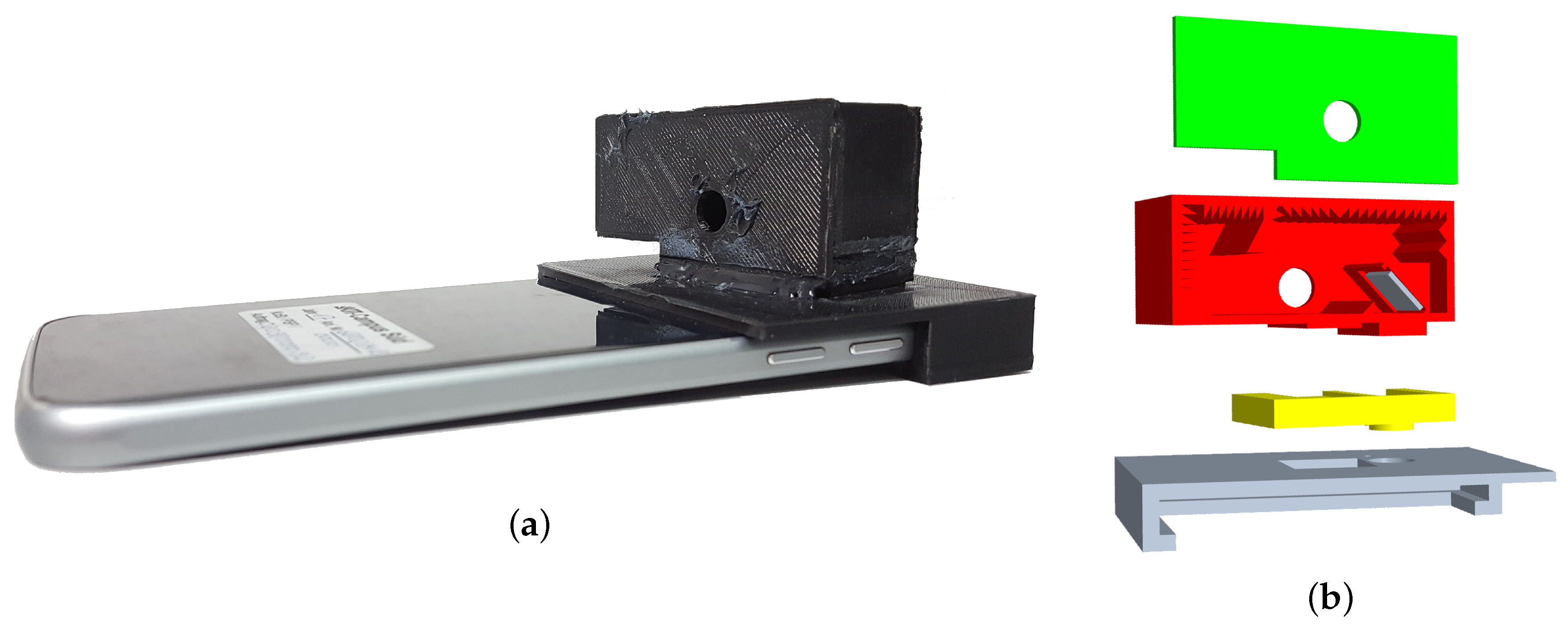
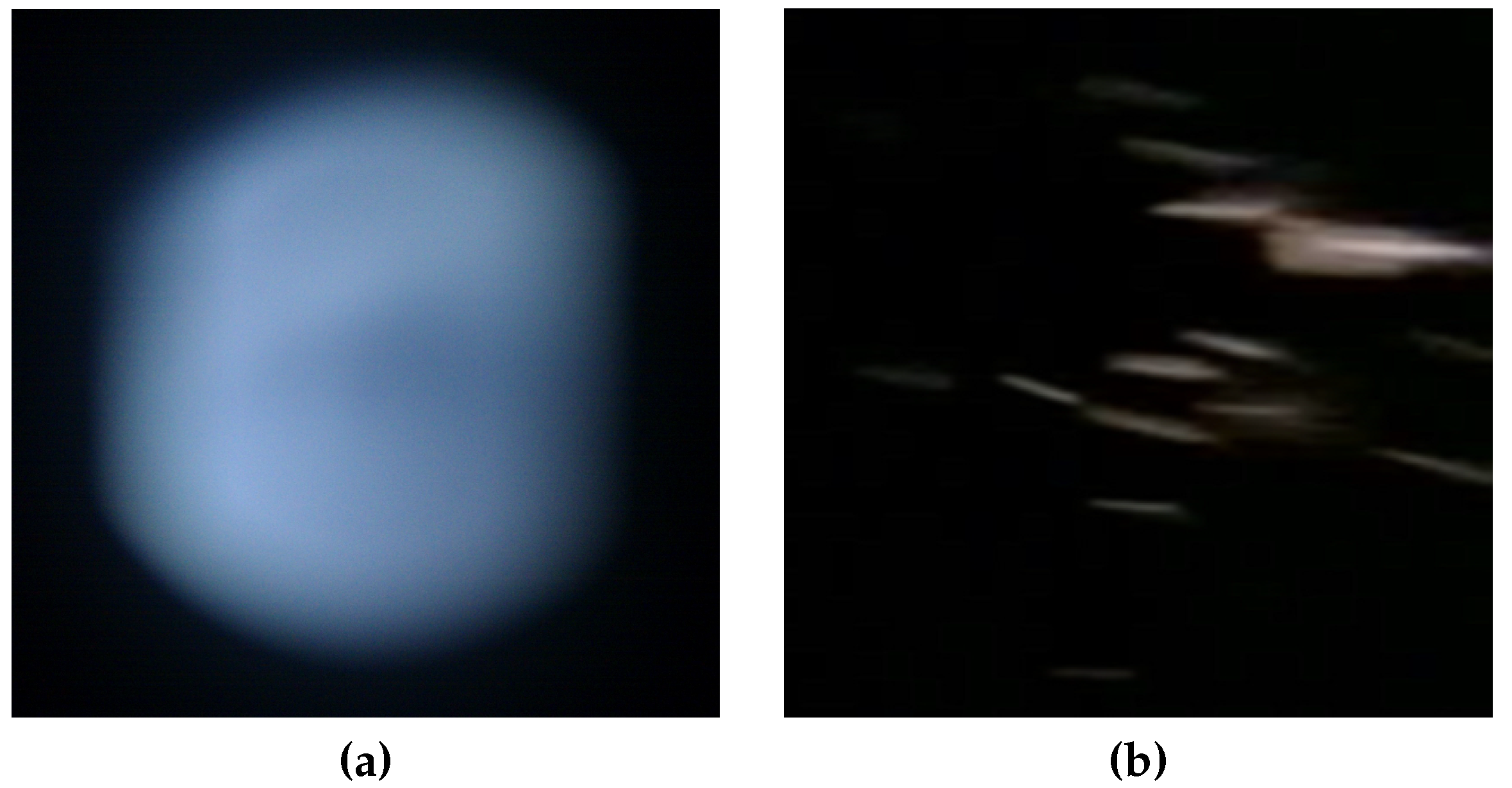
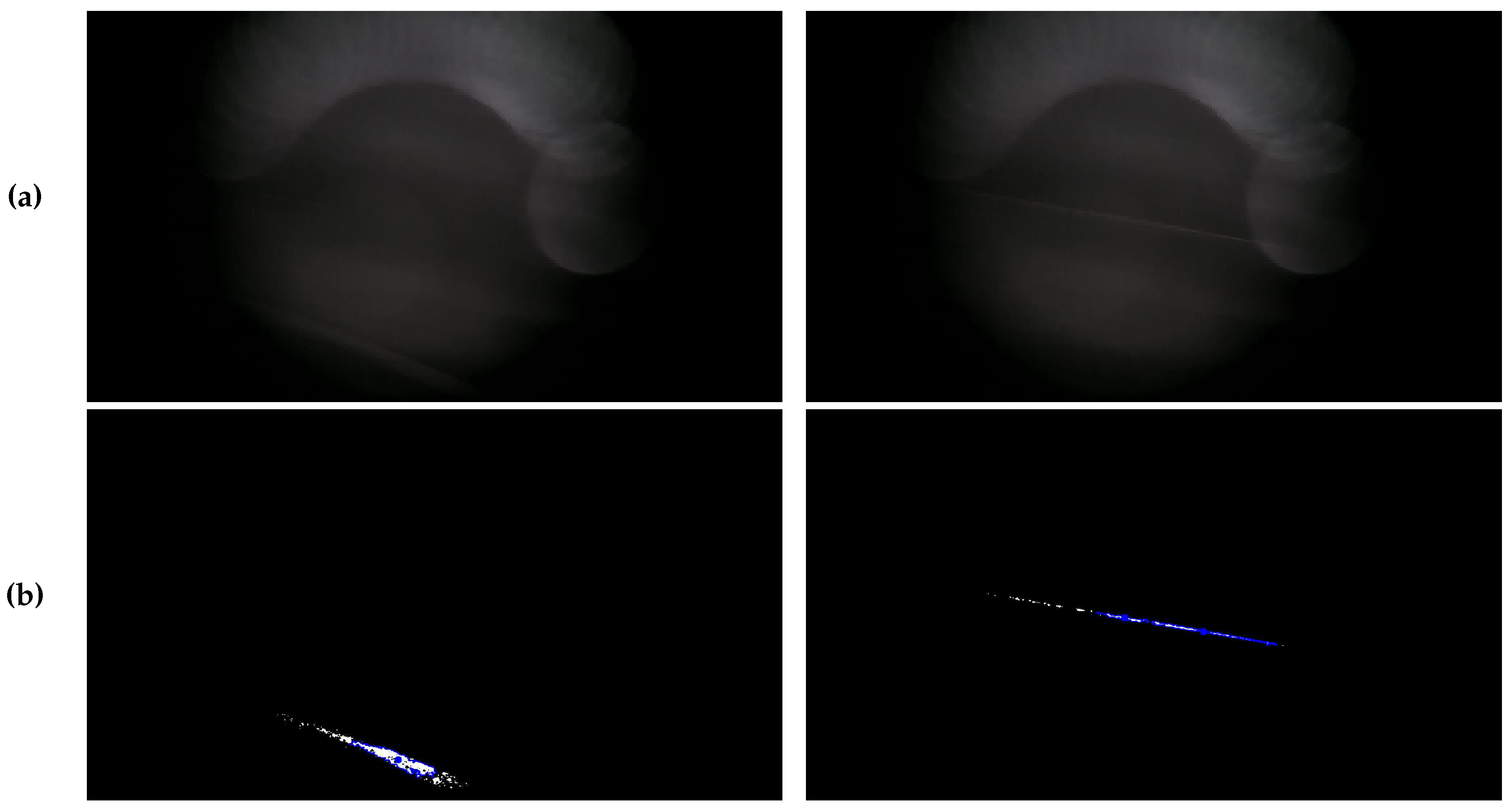
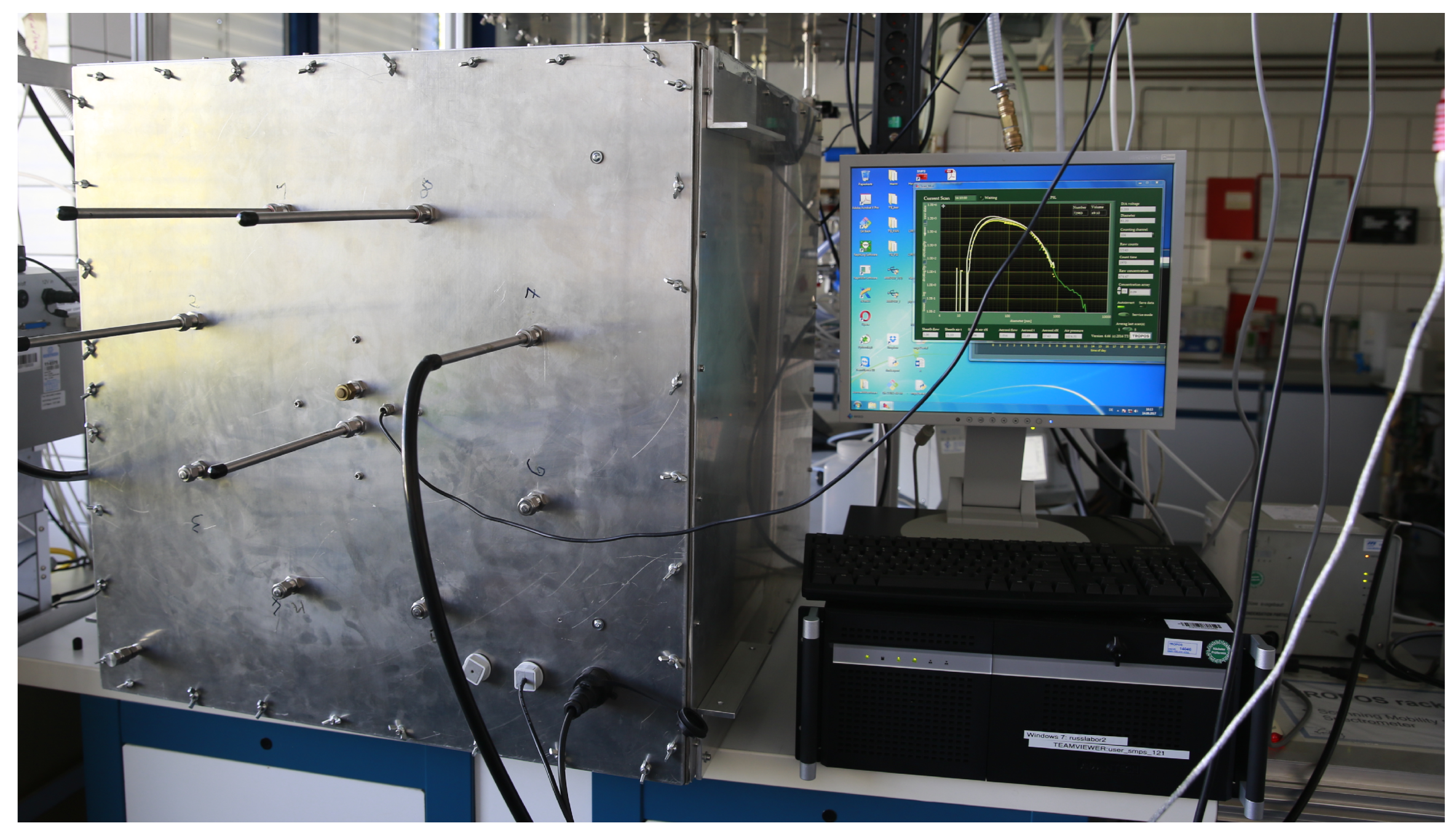


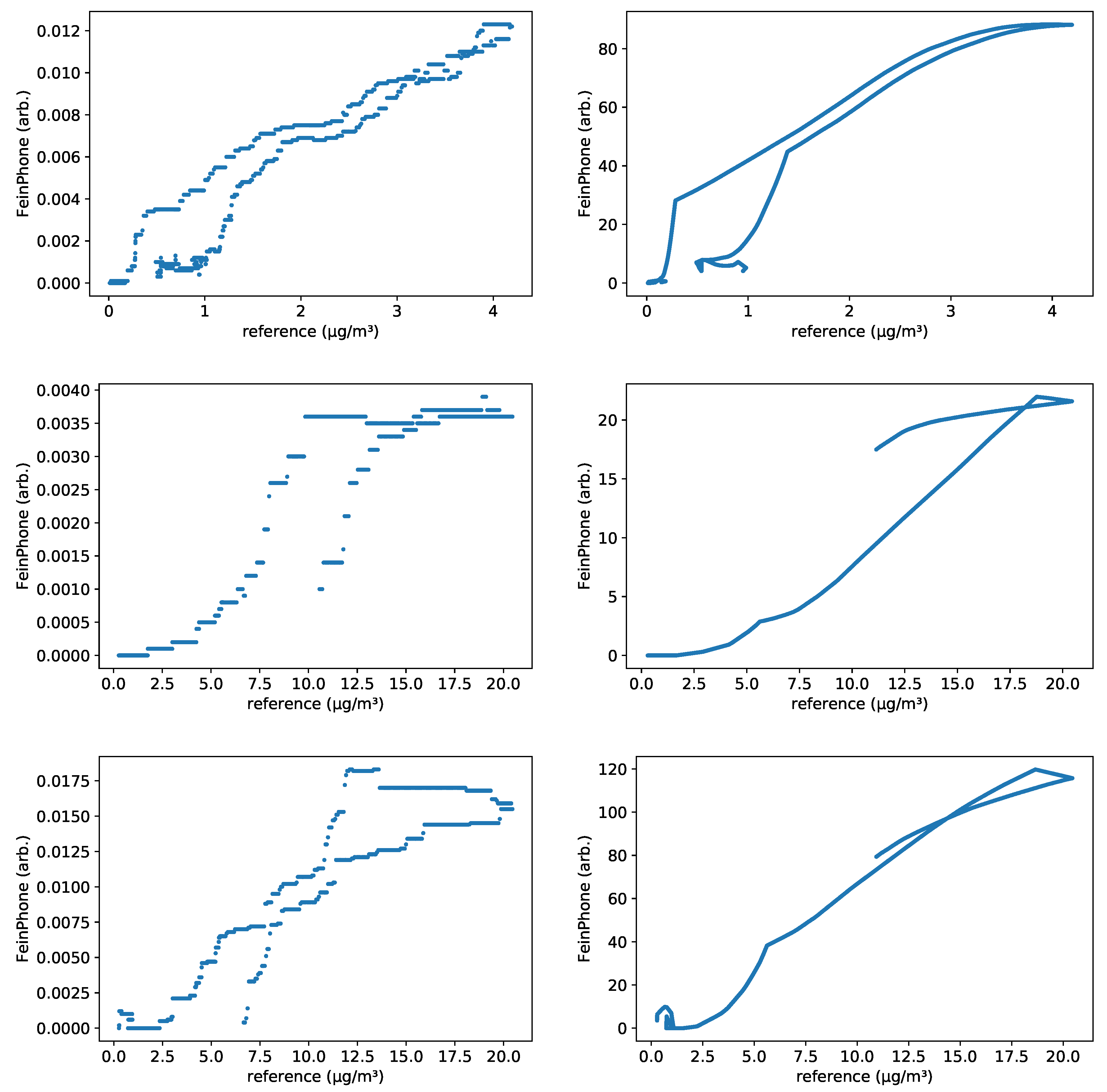


| Sensor | Fan | ISO | Shutter time | Framerate | Focal length setting | Resolution |
|---|---|---|---|---|---|---|
| B001 | yes | 400 | 30 | 10 (inf) | 1920 × 1080 | |
| B002 | yes | 200 | 30 | 10 (inf) | 1920 × 1080 | |
| B003 | no | 400 | 30 | 10 (inf) | 1920 × 1080 | |
| B004 | no | 200 | 30 | 10 (inf) | 1920 × 1080 | |
| B005 | yes | 400 | 30 | 10 (inf) | 1920 × 1080 |
© 2019 by the authors. Licensee MDPI, Basel, Switzerland. This article is an open access article distributed under the terms and conditions of the Creative Commons Attribution (CC BY) license (http://creativecommons.org/licenses/by/4.0/).
Share and Cite
Budde, M.; Leiner, S.; Köpke, M.; Riesterer, J.; Riedel, T.; Beigl, M. FeinPhone: Low-cost Smartphone Camera-based 2D Particulate Matter Sensor. Sensors 2019, 19, 749. https://doi.org/10.3390/s19030749
Budde M, Leiner S, Köpke M, Riesterer J, Riedel T, Beigl M. FeinPhone: Low-cost Smartphone Camera-based 2D Particulate Matter Sensor. Sensors. 2019; 19(3):749. https://doi.org/10.3390/s19030749
Chicago/Turabian StyleBudde, Matthias, Simon Leiner, Marcel Köpke, Johannes Riesterer, Till Riedel, and Michael Beigl. 2019. "FeinPhone: Low-cost Smartphone Camera-based 2D Particulate Matter Sensor" Sensors 19, no. 3: 749. https://doi.org/10.3390/s19030749
APA StyleBudde, M., Leiner, S., Köpke, M., Riesterer, J., Riedel, T., & Beigl, M. (2019). FeinPhone: Low-cost Smartphone Camera-based 2D Particulate Matter Sensor. Sensors, 19(3), 749. https://doi.org/10.3390/s19030749





